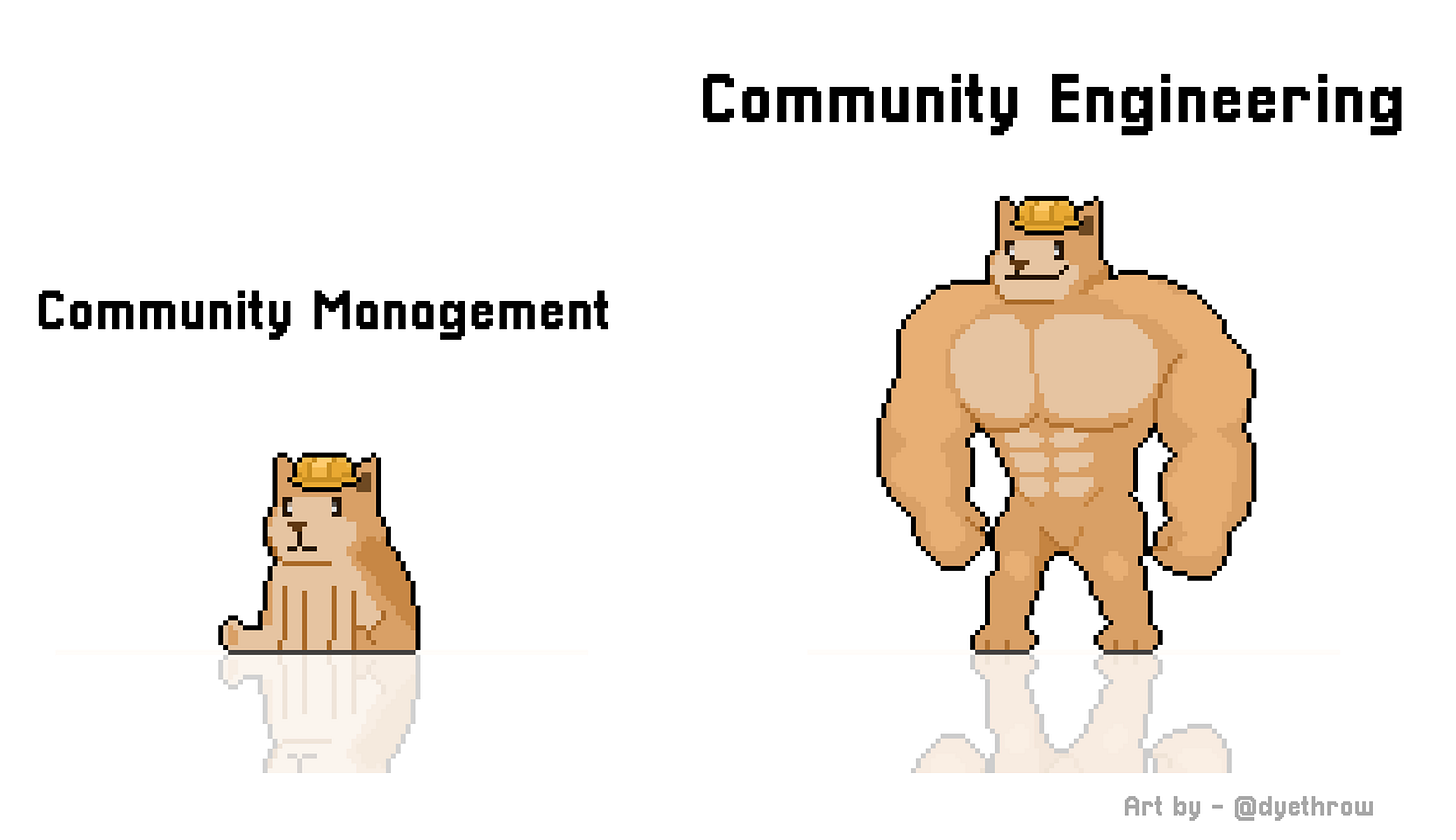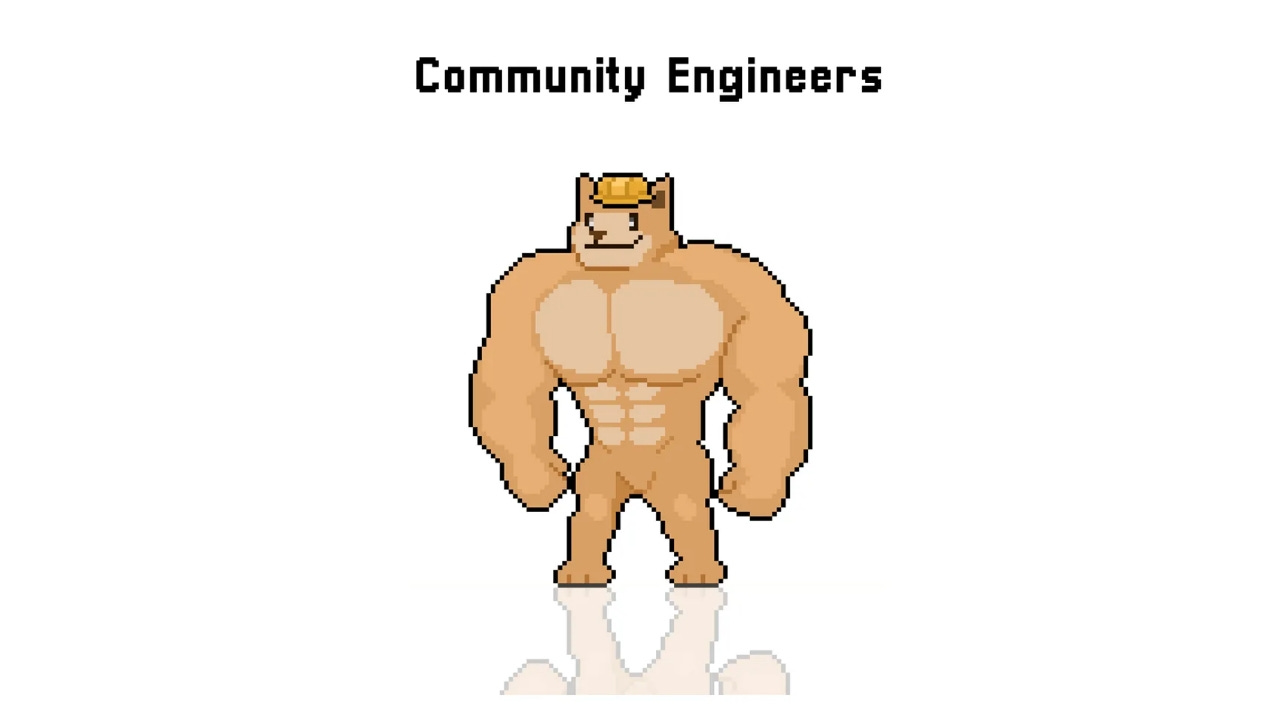Why does Community Engineering matter?
Changing our perspective and view about community building and management and knowing the reason behind the increase in demand for community-related roles
In the previous blog, we discussed the early problems that communities face and how community builders and managers can fall into either the Relationship Building Trap or the Number Building Trap, and how understanding these problems and potential solutions is the foundation of Community Engineering. If you haven't had a chance to read my previous writing, please do so (here) before proceeding with this one.
Why does Community Engineering matter? Why can’t we just settle on simply building Facebook groups or Discord servers and do the usual roles and responsibilities of a community manager and moderator? Why do we need to understand all of these things, and why over complicate building a simple online community?
These are some of the questions that may be running through your mind right now. If we could go back 3-5 years, not many companies or organizations would consider hiring a community manager or moderator, and even if some companies do have these roles, the majority of them are volunteer and unpaid. And this is the shift we are currently seeing as the demand for these roles grows as more companies, organizations, and start-ups recognize the value of building a community around their brand, products, and services. And I believe that more community-related positions will become available in the future (unless AI already learns how to build communities). So, as the job market shifts, it's important that we also shift the way we view and build communities in the digital space.
Advantages of communities to companies, organizations, start-ups, projects, and more!
I believe that we should first know the reason why more and more companies and organizations are now seeing the importance of building a community around their products and services. What could be the reason, and how does the Web3 space influence this shift?
With the Web3 space and the different projects within it starting to go mainstream, we could see that out of many things projects and startups in the space focus on, establishing a community is one of those things that cannot be removed from the equation, as it is also one of the ideas that Web3 has put an emphasis on with the concept of decentralization (giving back power and ownership to people).
To give you a little bit about my thoughts, I believe that communities tend to also go along with the evolution of the Web. In Web2, we see that one of the greatest shifts is being able to connect online and build communities through social media platforms like Facebook, Twitter, or Youtube. Now, with Web3, the way we look at communities has also changed with distributed governance through DAO (Decentralized Autonomous Organization) and being able to build communities on-chain, in which everyone with a stake in the community could take part and vote on the decisions and directions the community will take. (I wonder what communities in Web4 would look like.) But going back, the reason why I believe Web3 has a huge influence on this is that as the Web and internet evolve, the concept of how communities work and how we view communities also tends to change.
My point is that Web3 changed how we look at and value communities, as back then the challenge for projects and start-ups was to find their first million users, but now it's finding your first million community members. Why is this the case?
From a start-up and business standpoint, building a community out of your user base comes with a lot of advantages. With all of these advantages in mind, a lot of companies, organizations, and start-ups already see the need for someone to build and manage their communities. These are just some of the reasons why I believe companies and organizations are already building communities.
ADVANTAGE #1: A Better Way to Connect
One of the advantages of building a community around a brand, product, or service is that it's easier to collect user feedback from your community and identify any pain points they are encountering. The great thing about collecting user feedback from a community instead of doing it individually is that your community could help you identify what feedback truly matters to them. Encourage your community members to post and publish their feedback, ideas, and suggestions, then see what feedback stands out and is well received by the community.
Another thing worth mentioning is that you could easily run different studies, user research, and experiments within the community as opposed to doing it through emails or individually reaching out to your users. You could run different surveys to get their insights, identify the response of your community to the updates and improvements to your product or service, and be able to test new products and features early on in your community to collect their feedback and suggestions before releasing them to all of your users.
ADVANTAGE #2: Platform for Scaling User Base (A great platform for viral engine of growth)
If you are not familiar with the viral engine of growth, it's one of the engines of growth that is mentioned in the lean start-up movement. It is when your focus is on acquiring new users and customers through virality and growth is fueled by referrals from existing users, or in this case, existing community members. Communities are a great platform for this engine of growth, as your community members could be the ones to work with on giving you leads, spreading the word, and inviting new users for your product and services.
Another great thing about communities is that they are a one-stop-shop for everything related to your product or company. Community members could ask questions, see positive reviews and feedback from other users, and even figure out ways to utilize the product and be able to be much closer to the team behind the company. Your community could also help you identify what we call "super users." To give you a very simple definition, "super users" are users who really love the product, service, or thing your team is building.
You could easily identify them as they are very active within your community. They could be creating content about your product, posting valuable feedback, answering different questions in the community, or giving your team ideas and insights on a regular basis. These are the perfect community members that you could onboard on your team as a community manager, moderator, advocate, or ambassador, as they could definitely help you scale your community and user base. Without a community, identifying "super users" would be a challenge. We will discuss more about this in my next blog about building your community engineering team.
ADVANTAGE #3: Cost-Effective
This could be one of the main reasons why a lot of companies and organizations are already giving importance to building a community, as it is cost-effective. Instead of running different huge marketing campaigns and advertisements that most of the time are a huge percentage of the budget of companies and start-ups, why not significantly reduce your customer acquisition cost (CAC) by building a community that would serve as a funnel for your product? I am not saying that we will totally not be spending on marketing campaigns and advertisements, but the point is being able to have your community as another way of creating conversions in a cost-effective way.
We know that not all of your community members are already users, investors, or fans of your product, but you could organize different initiatives, events, and campaigns exclusive to your community to convert these community members into your users. Most of the time, these community initiatives and events will not cost you even a single cent, and this is also the reason why most startups and Web3 projects consider building a community around them a need. as most of them have little to no budget for marketing or advertising. Communities are valuable in such a way that they facilitate a more advantageous avenue for companies and start-ups to do marketing while still being cost-effective at the same time.
What should be the shift in thinking for Community Builders?
We now have some ideas as to why community-related roles are currently in demand, and we mentioned at the beginning of this blog that this shift in the job market should also shift how we view community building and management. Why is this the case? Why can’t we just settle with the traditional tasks and responsibilities of a community manager and moderator?
Some of you might think that changing or shifting the way we view communities from a community builder perspective is a bit over complicating it, as a lot of us view community managers and moderators as those individuals who create discord servers, brainstorm different events, host Twitter spaces, and perform other usual tasks of community managers. I believe that as more and more communities require creation and building, it's important that we do it the right way.
Zab, So what if we build communities the usual way we are used to? Why do we need to change it?
The Traditional Community Manager Starter Pack
Bob has been hired by Company A as a community manager to build and manage the community around their upcoming Play and Earn game. Bob had the following on his list as his plan for building this community:
Create a Discord server (Create channels, fix permissions, add roles).
Invite people to the server (Grow numbers and make Company A happy).
Brainstorm events for the community (Twitter space, AMA, mini games)
Hype the community for the upcoming launch (Create campaigns, giveaways, and partnerships).
Let’s try to expand this list of Bob's plans for building this community. First, he created a Discord server for the community, making sure to have the right emojis on each channel and cool colors and great names for each of the server roles. Now, after two days of setting up the server, he's ready to launch this Discord server, so he heads straight to Twitter and Facebook to invite people to join in and grow the numbers of the Discord server. After a few days, Bob saw that not a lot of people were joining the server, so he initiated a "Top Inviter Event" in the community to encourage community members to invite their friends to join the Discord server. Bob has grown the Discord server from 100 to 10,000 members in just a week. What a great job Bob is doing, you might say. But Company A observed that only 2-3 members are chatting on the general chat, and engagements are close to 5–10 messages per day. So Bob is staying up all night now, thinking hard about an event to hype the community for the upcoming launch, so he thought of doing some AMA and Twitter space with a whitelist giveaway in it, but only 10 out of the 10,000 community members attended.
He tried thinking of other ways to hype the community, so he thought of adding mini games to the Discord server and announcing tons of partnerships for Company A on Twitter, which created a little bit of hype, but the hype only lasted for a few days. So he proposed onboarding new community moderators as he believes that the current team is doing a bad job keeping the community engaged and it's time to look for new community wizards to join the team, but even after onboarding a new set of community team members, the community is still dormant with only a few members engaging.
Reflection:
The twist about this story is that it's not about Bob; it's about most community managers and community builders now. Most of us tend to have the same thought process as Bob and tend to focus our community-building efforts on the ones that will bring the most hype and the most numbers (The Number Building Trap). A large contingent of community builders now tends to focus on the wrong things and wonder why their efforts in engaging the community have little to no effect. We think that it's all about hyping the community, organizing tons of AMAs and giveaways, and closing hundreds upon hundreds of partnerships. We are not saying that creating hype is bad, but as mentioned in the last blog, it still depends on your goal of building the community in the first place.
The Community Engineer Starter pack
Paul has been hired by Company B to be their community manager to build a community around their upcoming Play and Earn game. Paul also has a list of his plans for building this community.
Identify the purpose of this community (value exchange).
Make a simple Discord server (2–3 channels, permissions, and roles).
Invite people to the Discord server (onboard initial community members).
Brainstorm events and initiatives for the community (knowing and understanding the community members).
Now let’s try to expand on Paul's plan for building this community for Company B. First, he identifies the purpose and goal of this community. He works with the team on identifying first what value this community could provide to its members and what the mechanism of value exchange between the team and the community would be. After this, he headed on to creating a simple Discord server with 2-3 channels, permissions, and a few roles. He knows that the rest of the improvements will come from the feedback and suggestions of the initial community members, so after only 1-2 hours of setting up this Discord server, he launched it through Twitter and Facebook. But just like with Bob, not a lot of people joined the server, but Paul didn't want to fall into the number building trap, so he decided to take this time to learn more about the initial community members who joined, so he initiated a fireside chat to learn more about the members.
He was able to know what social media channel they saw the invite on, what made them join the server, and ask for some feedback for improvements in the server. Based on his collected insights, he now knows that the community has attracted people from Europe and Asia through Facebook, so based on the suggestions of the community, he has brainstormed a campaign focused on audiences from Europe and Asia, and he has tried to get the help of one of the very active members of the community (a super user) to make this campaign possible. He did not stay up all night thinking of an event or initiative to execute, but he brainstormed with his community. As days go by, more and more community members who are really interested in the game join the community. Paul continued hosting fireside sessions with the community to learn more about their pain points, things they want to see in the game, and further improvements in the community. Paul is always equipped with insights and facts, and the community is happy because they feel that their feedback and suggestions are heard.
Reflection:
Bob and Paul do have the same goal of creating an engaged and healthy community, but the main difference is the way they do it. Bob uses strategies that he usually sees in how others do community building, while Paul uses methods that follow engineering and scientific methods. Community builders and managers all share the same goal of building a strong, healthy, and engaging community, and in order to formulate strategies that would work best in achieving that goal, we would need to be guided by the right perspective and view about community building.
I am 100% sure that within your community building journey, you are seeing community members say things like, "The team is not listening," or "None of them is listening to us." Your common response to these feedbacks might be to ban, kick, and label them as FUD, but what if our community members are telling the truth? What if we are not really listening to them?
Why is it that most community managers and builders take so much time figuring out with themselves what kind of event their community would love, what kind of improvement they can make within the community, or how they can support and help their community? even if most of the answers to these questions are just one question away from their community members. It's very important that we always take the time to talk to our members to gain more insights and understand what we could improve in our community. We don't need to carry the world on our shoulders. At the end of the day, we build the community for them, not for us or the team. Listening to them doesn’t mean that all feedback will be implemented, but it's an action that they would appreciate, as at least their feedback and suggestions are heard and considered. This is just one of those things that most community builders and managers get wrong. Even the premise of identifying the purpose or goal of the community is not something that a lot of community builders do.
But you might say, "Zab, but the success of the community still depends on how the project will perform, right?"
Some might say that a community might still fail if the team were unable to deliver on their promises and if the product or services they offered did not meet the expectations of the community. To some degree, this is true because some community builders and managers tend to unintentionally set this as the purpose and goal of their community. Building a community solely for the purpose of giving updates and news about the project and product will make the interactions and engagements of the community members solely dependent on those updates and news as well. In simple words, if there are no new updates or news coming from the team, there will also be no new engagements and interactions within the community. And in this case, if the project dies, the same thing happens to the community. That’s why it’s very important that at the beginning of building any community, we clearly define and establish the purpose and goal of the community.
Conclusion:
The aim of this blog is NOT to give you a set of clear instructions or a playbook that you should strictly follow on how to build a perfect community. Strategies for developing and managing a community will always differ from one another. My purpose in creating this blog is to provide insights and direction as you embark on your community building journey, as well as to help change how many people perceive community building and management.
The concept of Community Engineering matters NOT because it sounds good or would be a great title to have on your resume, but because it changes how we view building and managing communities. Building a community is not just creating a Discord server, Facebook group, or Telegram group; it's engineering a COMMUNITY with real people in it. YES, people with emotions, feelings, characteristics, and behaviors, and it's our role as community builders to work on understanding these and create safe spaces for them and a family that they could be a part of.
Now to give a bit of a recap of the things we have covered on this blog. We have been able to touch on the reasons why more and more companies are already giving importance to building a community around their brand and products, which has led to an increase in demand for community-related roles. We also touched on why Community Engineering matters and why we should change our perspectives and views about community building and management.
How could I get started with Community Engineering? And how could I build my Community Engineering team?
We already understood the reason why Community Engineering matters, and in our upcoming blog, we will be discussing more insights on the principles and foundations of Community Engineering. We will also discuss how you could get started building your Community Engineering team if you happen to be a founder or an existing community manager who is currently looking to build a community team for a company or project.
If you are interested in learning more about Community Engineering, feel free to subscribe to my Substack channel and reach out to me (here) so we can discuss further how we could better build and manage communities. If you are already a community builder and you find this article helpful in some way, feel free to share it with other community managers and builders you know. Feel free to leave your feedback and insights about this blog. Thanks a lot, GM!
Some of the images and graphics used is generated through the power of DALL-E https://labs.openai.com/








